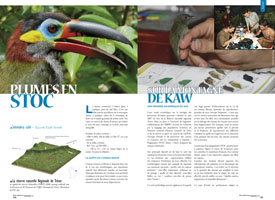The mist is beginning to disperse, allowing a few patches of blue sky to peep through. It is the beginning of a fine morning on Montagne Trésor, a few peaks along from Montagne de Kaw in the French Guianese mountain chain of the same name. Gradually the concert of birdsong greeting the sunrise dies down and the forest becomes calm once again.
Suddenly the walkie-talkie crackles into life:
“Table, calling table, net number 37 here, we have a control.”
“Table here, go ahead”. J
“R47 521, a PIP ERY.”
“OK, I’ve got it. It’s a bird we ringed this morning. You can release it.”
Searching for the ringed bird
The bird is free once more and rapidly disappears from the view of the ornithologists, who immediately resume their laborious way struggling through the undergrowth. But what are they looking for? It’s not easy to explain but, to put it simply, you could just say they are trying to find out more about the forest birds in the territory.
A first in South America
This scientific study into the biology of the forest passerines of French Guiana started in June 2007 in the Trésor Regional Nature Reserve. It was set up on the initiative of the bird-ringers working for the CRBPO (Centre for Research into Bird Populations by Ringing, part of the National Museum for Natural History in Paris) and the reserve, with the support of GEPOG (Group for the Study and Protection of Birds in French Guiana). This standardised study is called the STOC-Trésor Programme (where STOC stands for Suivi temporel des oiseaux communs, time monitoring of common birds).
Its primary aim is to monitor bird populations within the territory under study with an eye to obtaining figures for trends in their population numbers. The ornithologists are endeavouring to find answers to questions including: which species are present? Are they common, nesting, or migratory? What is their density? Do they return to the site each year? How many young do they have each year?
This methodical monitoring also makes it possible to build up a wide range of information about the life of these discreet birds (their reproduction period, the time when they molt, and choice of biotope) as well as criteria making it possible to determine their age and sex. Our current knowledge of the biology of birds in French Guiana is still highly fragmentary. For instance, it is still not known exactly when and how frequently the various manakins reproduce, nor the average life expectancy of a wedge-billed woodcreeper, even though these are both very common birds.
The principal behind a STOC programme is to catch, ring, and try to recapture and monitor as many birds in a given sector as possible using appropriately sited catching nets. Analysing the results should provide highly revealing information about the dynamics of the population under study, that is to say about the diversity and number of birds living in the zone and how this changes over time. In short, are numbers stable or not? Which species are on the up and which are dwindling?
This sort of study is ideal for statistical processing and is particularly used in France to identify variations in the density of passerine populations.
The STOC-Trésor programme is the first of its kind in French Guiana and in South America. Its protocol is based on opening 40 nets (each twelve metres long) for a period of twelve hours (from midday to 6pm and from 6am to midday) every day, spread out over 4 hectares of primal forest. This is done every other month for an initial period of three years, giving 18 capturing sessions in all. At least four qualified bird-ringers accompanied by four assistant ringers are required for each session so as to safely manage the 100 or so birds captured. But as much help as possible is appreciated to carry the 400kg of equipment that needs to be set up on site, and to erect the perches and hang the nets.
Understanding more about the birds in the forest
Midday on Saturday. The forty nets are finally opened and work starts to disentangle the birds. There is no time to be lost. The birds caught in the nets will try to free themselves by beating their wings and this will only ensnare them further. But there is no cause for concern as the ornithologists are practiced and can keep up the pace. The birds are carefully and skilfully disentangled from the nets before being placed in a little individual cloth bag where they are held before being ringed by an expert.
Each individual is identified (species and subspecies) and examined in detail so as to determine as far as possible its age and sex, tagged with an aluminium ring with a unique code on it (a ring from the Paris Museum) or monitored (for recaptured birds that have already been ringed), measured, its place recorded (the nets are numbered), sometimes photographed, and finally released. The whole operation takes ten minutes or less.
This operation goes on until dusk and then starts again the following morning from dawn until midday. Each of the bird handlers will have trekked fifteen or so kilometres in all through the forest, clambering over tramps and roots in what one might term variable weather conditions. But that is of little importance for a bank of fundamental information is built up during these rare encounters between man and wild birds. The length of their wings, beak, and tail provide information about the morphology of the species to be found in French Guyana. If a brood patch is detected (for sitting on eggs) this provides information about when the animal reproduces. Studying the general level of adiposis (fatty tissue reserves) and the bird’s mass provides important information about their health. The lack of data in the literature about age criteria and changes in the plumage of Amazonian passerines means that the Trésor STOC programme is pioneering new knowledge.
After six capture sessions (June, August, October, and December 2007, and March and May 2008) 433 birds of 56 different species have been ringed. 146 individuals already tagged have been recaptured, providing initial information about their loyalty to the site, reproduction, and determining age. The level of recapture (about 34%) is high, showing that this programme relates primarily to birds that are loyal to the site, and thus confirming that this is an appropriate protocol for the tropical forest.
This programme to ring wild birds will culminate in a scientific publication at the end of the three-year study. Three years is a comparatively short period of time for the golden-headed manakin (Pipra erythrocephala in Latin, and PIP ERY to the ringers) to deliver up some of its secrets. In the meantime, complementary information will be available from the Trésor Regional Nature Reserve and from GEPOG.




 English
English Français
Français  Português
Português 










 Télécharger l'article en PDF est réservé aux abonnés Web !
Télécharger l'article en PDF est réservé aux abonnés Web ! 
 Pas de réaction
Pas de réaction Comment!
Comment!


 Voyages avec Tooy. Histoire, mémoire, imaginaire des Amériques noires : Editions Vents d’ailleurs, 2010
Voyages avec Tooy. Histoire, mémoire, imaginaire des Amériques noires : Editions Vents d’ailleurs, 2010
 Guyane. Produits du terroir et recettes traditionnelles. L’inventaire du patrimoine culinaire de la France : Editions Albin Michel, 1999
Guyane. Produits du terroir et recettes traditionnelles. L’inventaire du patrimoine culinaire de la France : Editions Albin Michel, 1999
 Alunawalé, un voyage à travers les milieux naturels de Guyane : Office National des Forêts, 2009
Alunawalé, un voyage à travers les milieux naturels de Guyane : Office National des Forêts, 2009
 Augusta Curiel, Fotografe in Suiriname 1904 – 1937 : Libri Misei Surinamensis, 2007
Augusta Curiel, Fotografe in Suiriname 1904 – 1937 : Libri Misei Surinamensis, 2007


